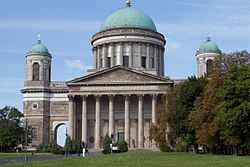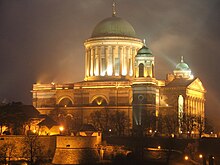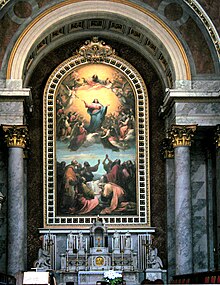Cathedral of Our Lady and Saint Adalbert
| St. Adalbert's Cathedral (Esztergom) Hungarian Nagyboldogasszony és Szent Adalbert főszékesegyház |
|
|---|---|
 Front view of Esztergom Cathedral |
|
| Data | |
| place | Esztergom |
| builder | József Hild |
| Construction year | 1822 to 1869 |
| height | 100 m |
| Coordinates | 47 ° 47 '56 " N , 18 ° 44' 11" E |
| particularities | |
| Cathedral Church of the Archdiocese of Esztergom-Budapest | |
The main cathedral of Our Lady and St. Adalbert ( Hungarian Nagyboldogasszony és Szent Adalbert főszékesegyház ), the Esztergom Cathedral , is the cathedral church of the Roman Catholic Archdiocese of Esztergom-Budapest . It is located in Esztergom (German: Gran), the former Hungarian capital.
The cathedral is dedicated to Mary, the Mother of God , who was taken into heaven, and to St. Adalbert of Prague . Its history extends from 1001 to 1869. As caput, mater et magistra ecclesiarum hungariae (“head, mother and teacher of the Hungarian churches”), it is the largest church in Hungary and is ranked 18th among the largest churches in the world.
history
The first church was built between 1001 and 1010 under the Hungarian King Stephen the Holy . It existed until the 12th century and was destroyed by fire. After a new building, the new cathedral survived the Mongol invasion of Hungary in 1242 . Under Wenceslaus III. It was repaired by Bohemia, who was running for the Hungarian throne, and made an episcopal church. The bishops enlarged and embellished them in the centuries that followed. A library was established near the basilica and was considered to be the second most important in Hungary.
In 1543 the basilica was captured by Ottoman troops. Archbishop Pál Várdai (1526–12 October 1549) and the cathedral chapter had already fled to Nagyszombat (today Trnava (Tyrnau) northeast of Bratislava in Slovakia) and were able to save a large part of the cathedral treasures. The cathedral chapter remained in exile in Nagyszombat until 1820. During the 140-year occupation by the Ottomans , the castle hill was under fire for four weeks and the buildings there were therefore largely destroyed: during the conquest of 1543, during the unsuccessful siege of 1594 by Austrian troops, in 1595, as the castle hill for ten years was retaken by the Austrians and when it was finally retaken in 1686 by the Habsburg troops. The rebellious Kurutzen under Franz II. Rákóczi (* 1676, † 1735), who conquered the castle hill in 1706 , also caused considerable damage , whereby only the burial chapel of Archbishop Tamás Bakócz (1489–1521) of the cathedral remained intact. The strategically located castle hill was then occupied by Austrian troops until 1771.
It was not until 1820, under Archbishop Sándor Rudnay , that the seat of the archbishopric and the cathedral chapter were moved back to Esztergom and the decision to build a new cathedral was made. She received the status of the mother church of Hungary.
As a first step, Rudnay commissioned the head of the imperial court building office in Vienna, Ludwig Remy, to create designs for a new spiritual center on the Burgberg in Gran. Since Remy's working pace did not meet the primate's impatient expectations, he also commissioned Paul Kühnel - a subordinate of Remy's from Sopron (Ödenburg) - with the planning. When Remy found out about this, he put the job offended. However, Kühnel succeeded in submitting finished designs a few months later, on the basis of which the foundation work could begin and on April 23, 1822, on the day of Saint Adalbert of Prague († 997), the patron saint of the archbishopric, the foundation stone for the Construction was laid.
The ailing Kühnel asked his nephew, Johann Baptist Packh, for assistance in carrying out the plans. After Kühnel's death in 1824, he was in charge of the construction work, which was carried out in several places at the same time. After the completion of the crypt, the Bakócz Chapel was relocated 17 meters and 8 meters higher. Rudnay's restless efforts did not meet with any sympathy, so that after Rudnay's sudden death in 1831 , the court chamber in Vienna immediately stopped construction.
Eight years later, the court chamber had new, simpler plans drawn up by Peter von Nobile (* 1774; † 1854), Remy's successor as head of the imperial court building office in Vienna, which Packh vehemently opposed.
From 1838 József Kopácsy , Archbishop of Gran, was under whom the work was reorganized, but it was interrupted by the murder of Johann Baptist Packh. He therefore commissioned József Hild (* 1789; † 1867) with the construction management in Gran. There were significant changes to the plans, because the construction was now continued in the classical style, with the side buildings of the cathedral, d. That is, the Primate Palace and the great seminary were dispensed with. At the same time, the side walls were raised, the supporting pillars of the dome removed and rebuilt, the vault of the dome was raised and the facade to the Danube was rebuilt. When Archbishop Kopácsy died in 1847, the building was already vaulted.
During the freedom struggle of 1848/49, construction came to a standstill and was only continued vigorously in 1849 by Cardinal Primate János Kritel Scitovszký de Nagy-Ker . When the building was far from finished, but usable, took place on August 31, 1856 in the presence of the Apostolic King of Hungary - Franz Joseph I, Emperor of Austria - to the sound of the Graner Mass composed by Franz Liszt for the occasion, the Missa solemnis for the inauguration of the basilica in Gran the solemn inauguration of the cathedral.
From 1867 Cardinal János Simor († 1891) was Primate of Hungary, who managed to complete the construction of the mighty basilica in two years, so that on November 1, 1869 the keystone could be installed.
architecture
The Esztergom Cathedral is an elongated hall church with a short transept in the classical style. Two chapels, the cathedral treasury and a reception hall complete the rectangular floor plan. The dome, visible from afar, rises above the crossing in the center of the building on a column of columns . The portal front, a representative antiquing portico , is flanked by two additions with the bell towers.
The interior of the basilica extends over an area of 5,600 m², it is 118 m long and 49 m wide. Twelve windows flood the interior of the church with light. With the dome (diameter 33.5 m), the cathedral has an internal height of 71.5 m and an external height of maximum 100 m, measured from the crypt .
Furnishing
The altarpiece with its dimensions of 13.5 x 6.5 m is the representation of the Assumption of the Virgin Mary , created by Michelangelo Grigoletti . It is the largest painting in the world painted on a single piece of canvas.
The Tamás Bakócz Chapel is the work of Italian masters from 1506 to 1507. It was made of red marble from Süttő and its walls are decorated with Tuscan Renaissance motifs. The chapel is an example of Renaissance art in Hungary.
The final resting place for the late archbishops of the Esztergom-Budapest Archdiocese is the crypt, which was built in the ancient Egyptian style. Among other things, the bones of the Hungarian “martyr” József Cardinal Mindszenty , who was a strong opponent of communism in Hungary, rest in it. His bones were transferred from Mariazell, Austria, to Esztergom on May 4, 1991 .
organ
With currently 89 stops on four manuals and pedal, the organ is one of the largest in Hungary. An expansion to 145 stops and five manuals is planned. It was completed by Ludwig Mooser in 1856 and has been expanded repeatedly since 1978. The current titular organist is István Baróti, who also teaches church music at the Theological Academy in Esztergom.
Web links
- Website of the cathedral , (English, Hungarian)
Individual evidence
- ↑ www.zoom.hu ( Memento of the original from December 4, 2008 in the Internet Archive ) Info: The archive link was automatically inserted and not yet checked. Please check the original and archive link according to the instructions and then remove this notice.
- ↑ Pál Cséfalvay: The Basilica, the cathedral treasure and the castle hill to Esztergom . Helikon Verlag, 1992, ISBN 963-208-253-2 , p. 8
- ↑ Pál Cséfalvay: The Basilica, the cathedral treasure and the castle hill to Esztergom . Helikon Verlag, 1992, ISBN 963-208-253-2 , p. 9
- ↑ Pál Cséfalvay: The Basilica, the cathedral treasure and the castle hill to Esztergom . Helikon Verlag, 1992, ISBN 963-208-253-2 , p. 9
- ↑ floor plan
- ↑ Organ Edition Lade (German)







